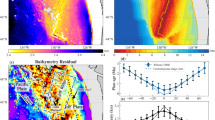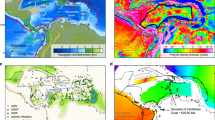Abstract
Along fast-spreading mid-ocean ridges such as the East Pacific Rise, there is an axial topographic high, 5–20 km wide, which stands 200–400 m above the background slope caused by thermally induced seafloor subsidence. There are also smaller topographic lows flanking the axial high along most of the East Pacific Rise from 20° S to 15° N. The existence of these lows is predicted by models of the origin of the axial high. One model postulates that the axial high is created by buoyant uplift from a narrow zone ofconcentrated partial melt extending tens of kilometres down into the mantle1,2,3,4. Another model requires no such buoyant zone, suggesting instead that the axial high is generated by dynamic, extensional stresses in the lithosphere and shallow asthenosphere5. Here we show that the observed asymmetry of the flanking lows can be used to distinguish between these two proposed mechanisms. Although either model can be adapted to match the asymmetry on individual profiles, the along-axis variation in degree of symmetry favours the model of dynamic, extensional stresses for the origin of the axial high and its flanking lows.
This is a preview of subscription content, access via your institution
Access options
Subscribe to this journal
Receive 51 print issues and online access
$199.00 per year
only $3.90 per issue
Buy this article
- Purchase on Springer Link
- Instant access to full article PDF
Prices may be subject to local taxes which are calculated during checkout





Similar content being viewed by others
References
Wilson, D. S. Focused upwelling beneath mid-ocean ridges: Evidence from seamount formation and isostatic compensation of topography. Earth Planet. Sci. Lett. 113, 41–55 (1992).
Wang, X. & Cochran, J. R. Gravity anomalies, isostasy, and mantle flow at the East Pacific Rise crest. J.Geophys. Res. 98, 19505–19531 (1993).
Magde, L. S. et al. Crustal and upper mantle contribution to the axial gravity anomaly at the southern East Pacific Rise. J. Geophys. Res. 100, 3747–3766 (1995).
Eberle, M. A., Forsyth, D. W. & Parmentier, E. M. Constraints on a buoyant model for the formation of the axial topographic high on the East Pacific Rise. J. Geophys. Res. 103, 12291–12307 (1998).
Eberle, M. A. & Forsyth, D. W. An alternative, dynamic model of the axial topographic high at fast-spreading ridges. J. Geophys. Res. 103, 12309–12320 (1998).
Buck, W. R. & Su, W. Focused mantle upwelling below mid-ocean ridges due to feedback between viscosity and melting. Geophys. Res. Lett. 16, 641–644 (1989).
Scott, D. R. & Stevenson, D. J. Aself-consistent model of melting, magma migration and buoyancy-driven circulation beneath mid-ocean ridges. J. Geophys. Res. 94, 2973–2988 (1989).
Sotin, C. & Parmentier, E. M. Dynamical consequences of compositional and thermal density stratification beneath spreading centers. Geophys. Res. Lett. 16, 835–838 (1989).
Su, W. & Buck, W. R. Buoyancy effects on mantle flow under mid-ocean ridges. J. Geophys. Res. 98, 12191–12205 (1993).
Gripp, A. E. & Gordon, R. G. Current plate velocities relative to the hotspots incorporating the NUVEL-1 global plate motion model. Geophys. Res. Lett. 17, 1109–1112 (1990).
Cormier, M.-H. & Macdonald, K. C. East Pacific Rise 18–19° S: Asymmetric spreading and ridge reorientation by ultrafast migration of axial discontinuities. J. Geophys. Res. 99, 543–564 (1994).
Cochran, J. R. Variations in subsidence rates along intermediate and fast spreading mid-ocean ridges. Geophys. J. R. Astr. Soc. 87, 421–454 (1986).
Forsyth, D. W., Dorman, L. M., Phipps Morgan, J. & Shen, Y. Anisotropy and lateral variations in shear wave velocity from propagation of Rayleigh waves across the MELT array. EOS Transactions AGU 77, 652–653 (1996).
Sandwell, D. T. & Smith, W. H. F. Marine gravity anomaly from Geosat and ERS 1 satellite altimetry. J.Geophys. Res. 102, 10039–10054 (1997).
Phipps Morgan, J., Parmentier, E. M. & Lin, J. Mechanisms for the origin of mid-ocean ridge axial topography: Implications for the thermal and mechanical structure of accreting plate boundaries. J.Geophys. Res. 92, 12823–12836 (1987).
Acknowledgements
D. Scheirer was helpful in obtaining some of the bathymetry and gravity data used for this study; M. Parmentier assisted us in formulating the conceptual and numerical models. This work was supported by the US NSF.
Author information
Authors and Affiliations
Corresponding author
Rights and permissions
About this article
Cite this article
Eberle, M., Forsyth, D. Evidence from the asymmetry of fast-spreading ridges that the axial topographic high is due to extensional stresses. Nature 394, 360–363 (1998). https://doi.org/10.1038/28596
Received:
Accepted:
Issue Date:
DOI: https://doi.org/10.1038/28596
This article is cited by
-
Seafloor asymmetry in the Atlantic Ocean
Journal of Ocean University of China (2004)
Comments
By submitting a comment you agree to abide by our Terms and Community Guidelines. If you find something abusive or that does not comply with our terms or guidelines please flag it as inappropriate.



